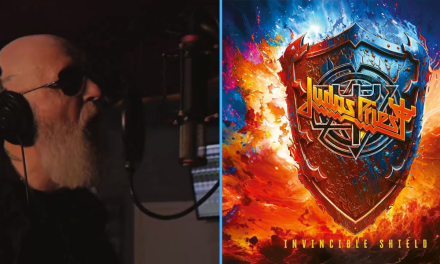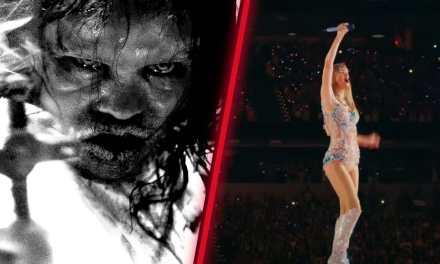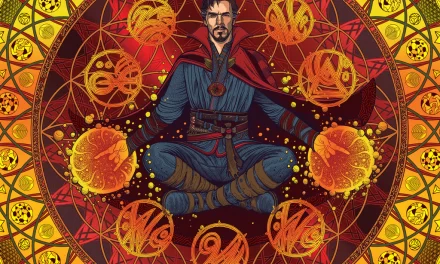If Black Sabbath are the grandfathers of heavy metal, then Judas Priest is the father that outdid them in almost every way. If you ask me to show someone what heavy metal is, I won’t hand them a copy of Paranoid or Master of Reality. I’ll instead hand them a copy of Screaming For Vengeance, British Steel, or Painkiller. That’s what Judas Priest means to the heavy metal community. Without them we wouldn’t have a classic look for heavy metal with studs and leather.
Thin Lizzy and Wishbone Ash might have been the first to use the twin-guitar attack, but Judas Priest was the one that solidified it in the heavy metal sphere. K.K. Downing and Glenn Tipton were and still are probably the best twin guitarists for any band. It was set to be the 50th anniversary celebration for Judas Priest this year. To make up for those shows being postponed, it’s high time for Judas Priest-A-Thon. The brother to the album by album reviews, Iron Maiden-A-Thon and the cousin to our series of Rush album reviews. You’re going to be getting a Judas Priest album review, every business day, until we’re all through.
1988’s Ram It Down was yesterday’s review. That album was a bit of a mixed bag, but overall was a solid effort from the band. It wouldn’t reinvent the heavy metal wheel like some of their earlier albums did, but what it did do, was bring back that edge and anger of Judas Priest. If you were pissed off about Turbo, Ram It Down was designed to bring you back. Judas Priest would return to the studio in 1990 with a new drummer in tow after Dave Holland left the band in 1989. That record would become Painkiller.
Background on Painkiller
First off, Judas Priest would replace Dave Holland with Scott Travis. The former Racer X drummer was a technical master and what the band really needed to keep developing. His arrival would immediately cement the sound and fury of the upcoming record. The band would head to another foreign studio for this record, leaving behind the cushy Ibiza Studios for Miraval Studios in France. It was mixed at Wisseloord Studios in the Netherlands.
Another new (old) addition for Painkiller was Chris Tsangarides in the producer’s chair. Tom Allom left a massive void that Priest filled with someone they knew previously. If you remember back to the Sad Wings Of Destiny review, you’ll recall that Tsangarides was a sound engineer for that album. So it came full circle for him to return to the band that gave him his first job. Painkiller was set to release around the world in March 1990. A subliminal message trial in the US involving the band would change that date though.
Subliminal Message Trial Derails Painkiller
In July of 1990, Judas Priest were brought to trial by the families of 20-year old James Vance and 18-year old Raymond Belknap. The two attempted suicide after apparently hearing subliminal messages on some of Judas Priest’s songs. In 1985, the two went to a playground with a 12-gauge shotgun with the intent to commit suicide. The pair were drunk and not in their right heads. The lawsuit states that the two were listening to Stained Class‘s “Better By You, Better Than Me”. Belknap shot himself and died instantly, Vance attempted suicide, but disfigured himself, and caused massive injuries to his head and face. He later died from complications from these injuries.
Judas Priest had to defend themselves in court stating that they weren’t aware of any subliminal messages on any of their songs. The prosecutors alleged that pair heard “do it” embedded in the song. This was apparently the trigger that set off the boys to attempt suicide. Vance and Belknap both suffered from depression and had overbearing parents. What it came down to was that the parents didn’t approve of the “garbage music” in Judas Priest.
The judge presiding over the case threw it out. The trial lasted from July 16th to August 24th 1990. The judge ruled that it was a studio error on the track and not some sort of subliminal message. In addition to this the band provided evidence that people can hear many different things when listening to something, especially when you tell them what to hear. It’s absurd to think that the band would want to kill their fans. Judas Priest and heavy metal would get a stigma from the trial nonetheless.
Back To The Background Of Painkiller
Painkiller released September 3rd, 1990. The album went Gold in the United States and peaked at Number 26 on the US and UK charts. The cover illustration was done by Mark Wilkinson. It depicts the title character of the Painkiller, a metallic angel that saves mankind from an apocalypse. It rides a motorcycle with buzzsaws for wheels and can be seen as a later form of the angel from Sad Wings Of Destiny.
The band went on the Painkiller World Tour to support the album. They played a majority of the songs from the record on this tour. The only song that hasn’t seen live play is “One Shot At Glory”. Songs like “Metal Meltdown” and “Leather Rebel” were dropped after a couple shows on the tour. But let’s get to the music.
1. Painkiller
I’m not going to mess around with this one. It’s the greatest opening track of any metal album in history. It might be the greatest metal track ever recorded. It’s an impossible song to sing on Rock Band 2. There’s only a handful of people on planet Earth that I would say could actually sing this song accurately. The cover that Death did on their record The Sound Of Perseverance comes very close to this version. It has all the ingredients of the best thing that Judas Priest has ever recorded. You can quote me on all of this.
Telling the tale of the mythical Painkiller, it’s a song that doesn’t skip out on the descriptive lines of lyrics. If you listen to metal, you’re spared of the Apocalyptic destruction. Not to mention that this song is one of the most brutal in their catalog when they play it live. “Painkiller” is a tour de force of a track that needs no introduction, no praise, because it’s just that good. You know this is a classic song that’ll pump even the most jaded and hateful of metal fan up.
From the opening drum beat to the ending solos by Tipton and Downing, you can’t get any better than this in metal or in music in general. If there’s a song I would want to get back the feeling of first listening to, it’s this one. The rare song that you can either air drum or air guitar to and look just as cool doing either, it’s the best song that Judas Priest has ever recorded.
2. Hell Patrol
Well, how exactly do you follow-up “Painkiller”? “Hell Patrol” is an admirable song to come behind the masterpiece of “Painkiller”. It doesn’t let up on the tempo of the album. “Hell Patrol” can be seen lyrically as about a variety of topics. It could be about jets in warfare raining death on people on the ground, it can be seen as about the band and their crew, or just about some biker gang causing trouble. The interpretation is up to you.
All I know is that this is a fantastic song that, if not for “Painkiller” opening the album, might be a perfect opening track as well. For now, it sits second on the album, and it’s a great one.
3. All Guns Blazing
With a sort of softer opening lyric section, you’d think that “All Guns Blazing” might let up on the tempo. Absolutely not. It’s another blasting, blitzing, and heavy track to keep up the assault on your senses. It tells the story of what I can imagine as a battle going on. The lyrics are full of description of the different weaponry and feelings on the battlefield. It’s one that seems pretty underrated from this album, but I was ecstatic when I saw them play it on the Firepower World Tour in 2019.
4. Leather Rebel
Another song, no break for your senses on Painkiller. “Leather Rebel” is an interesting one about what I can guess is some mythical being or person who rules the nighttime. The lyrics are a jumble of badass sounding phrases about the titular character. Funny enough, there’s a reference to this song in the game Fallout 3. In The Pitt DLC for the game, you can get a set of armor called “Leather Rebel”. The description for the armor says “as having been worn by a desert priest who said the armor was bulletproof, a theory which was proven false when put to the test”.
One theory that I might come back to is that Painkiller is actually a concept album about the coming of the character. We’ll have to get back to this theory later though.
5. Metal Meltdown
“Metal Meltdown” starts off with a blistering solo and continues into the heavy riff of the overall song. It speaks the incoming metal meltdown, and how it’s an explosive and apocalyptic event. This furthers the idea that Painkiller might be a collection of songs about the events surrounding the arrival of the mythical metal angel. As for the song itself, being the weakest song on Painkiller would probably mean you’re an incredibly strong song somewhere else. So I think it’s the weakest song here, but that doesn’t mean that it’s bad by any stretch of the imagination.
6. Night Crawler
Now for the song that used to scare the crap out of me when I was younger. “Night Crawler” continues the sonic speed assault on your senses, and your neck. Continuing with the apocalyptic theme of the rest of the album, “Night Crawler” tells about a mythical beast that returns to stalk victims in the night. The song begins with a thunderstorm rolling in, signifying the threat of the monster. You can really feel the terror the song portrays with this section right here:
Huddled in the cellar
Fear caught in their eyes
Daring not to move or breathe
As the creature cries
Fingernails start scratching
On the outside wall
Clawing at the windows
“Come to me” it calls
Atmosphere’s electric
As it now descend the stairs
If that doesn’t bring a chill up your spine, I’m not sure what will.
7. Between The Hammer And The Anvil
Another song that doesn’t relent one bit. “Between The Hammer And The Anvil” might be a mouthful to say but it makes up for that with being one of the heaviest tracks on the album. I don’t really know what this song is about, it’s lyrics are pretty hard to decipher. Someone should tell me in the comments or on Facebook, what they think. It has one of my favorite riffs in the Judas Priest catalog and this was a very early favorite from me. I saw them play it in just my second concert ever in 2008, and I was hooked ever since.
8. A Touch Of Evil
*Warning, the video above, is a shortened version, listen to the full version for the best experience*
The second single released off the album, “A Touch Of Evil” is a dense song that slows down the pace a bit on the album. Telling about the perils of making a deal with the devil or the “dark angel of sin”. You make a pact with the devil every time you go out and sin. The whole song has a feel of evil, mystery, and an overall eerie feeling that makes my skin crawl. Rob Halford was quoted in Metal Hammer saying that the lyrics have a metaphorical love meaning. Either way, it fits perfectly with the overall vibe of the album. Chris Tsangarides got a writing credit on this one for helping write the guitar riff. One of the best Priest songs in their catalog.
9. Battle Hymn/One Shot At Glory
A fitting end to Painkiller, “One Shot At Glory” begins with the instrumental “Battle Hymn”. Sending the metal faithful into battle, you’re rewarded with this closing track. Telling a tale of battle and war, you get the whole experience here. This is the only song from the album to not be played live at some point in the history of Judas Priest. It’s embarassing, but I originally thought this song was some bonus track on the album, so it took me ages to listen to it. I’m glad I did, because it’s a fantastic way to end Painkiller and the heavy metal journey that it takes you on.
Bonus Track: Living Bad Dreams
I’m going to highlight the bonus track included on re-issues and remasters of the album because it’s awesome. “Living Bad Dreams” is unlike some of the other songs on the album, while it’s not as fast as some, it’s just as heavy. I absolutely love the guitar riff on this song, where it takes a simple sounding riff and makes it into an emotional extension of what the narrator is feeling. What better way to describe sorrow and pain than the phrase “Living Bad Dreams”.
I think this one is good enough to have made the album, but I know 10 songs is a pretty number for albums, even if one is just technically an opening for “One Shot At Glory”. If you haven’t heard this one, give it a shot.
Painkiller Is The Shining Example Of Metal And Judas Priest
If you’d like me to finally tell you what I’d give to someone if they ask me what heavy metal is, it’d be a copy of Painkiller. Sure, Screaming For Vengeance or Paranoid might be a better choice for people who need some “easier” listening. But Painkiller is the pinnacle of Judas Priest. It’s the band at the absolute peak of their powers. You have Rob Halford’s voice going to places that only mythical beings were previously thought to reach. Glenn Tipton and KK Downing are at their best as a duo here. The whole album is forged in the fires of turmoil, anger, rage, and a referendum on Glam Metal.
Painkiller was my first introduction to Judas Priest after Screaming For Vengeance. It’s the grown-up, battle-tested, wise, version of that album. Track for track, pound for pound, there might not be a better album in any band’s catalog that stands up to what Painkiller offers you in the heavy metal genre. You tell me how much the energy picks up at a Judas Priest show whenever any of the songs from this album are played. When that either digital, or cloth background shows the mighty angel of metal riding across a barren, decimated landscape, you know people are going to go apeshit.
From the title track, to any other on the album, it stands the test of time. The metal angel rising from the wreckage of the past might be the most apt description for Judas Priest. They had to make Turbo/Ram It Down to get to this album. Scott Travis’s arrival in the band certainly helped this, because while Dave Holland was admirable on his albums, he got replaced by a drum machine, and couldn’t do any of the songs that Travis plays on this album.
More Praise For Painkiller And Turmoil For Judas Priest
It would take many years before Judas Priest would be able to put out a record that would meet the quality of this release. Painkiller stands as the metal beacon for the rest of the community. With the success and triumph of Painkiller would come turmoil and sadness for the band. Rob Halford, wanting to do more musically, and feeling tensions with the rest of the band would leave in 1992. He started a band called Fight, that played more thrash style, street metal. To release music under this name, Halford had to leave his contract with Judas Priest.
This obviously was a huge blow and almost catastrophic for the band. Iron Maiden lost Bruce Dickinson around the same time, but recovered with Blaze Bayley. Judas Priest didn’t have that luxury. Bruce Dickinson proved to be indispensable, and Rob Halford is irreplaceable. His voice and vocal range are impossible to replicate. Instead of forging on, Judas Priest would take a break. The longest break for the band, it took four years to find someone to hold a candle to Halford.
Originally a singer in a Judas Priest cover band, Tim “Ripper” Owens was selected as the new lead singer for Judas Priest in 1996. We’ll get into that more with the next review of Jugulator when we come back over the weekend.
Final Thoughts And Score
As for Painkiller, it’s the best album Judas Priest has ever made in my opinion. It’s a perfect 10/10 and belongs as the crown jewel of the crown of Heavy metal. You can’t get any better than it, anywhere. If you’re teaching a youngling about the ways of heavy metal, an opening dose of Painkiller will get them hooked immediately.
For more on Judas Priest, heavy metal, or any other general pop culture, make sure to check back to That Hashtag Show.
All images and audio are courtesy of Judas Priest.





